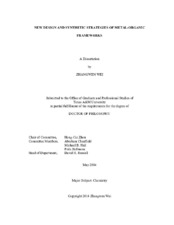| dc.description.abstract | Metal-organic frameworks (MOFs) are newly emerged porous materials. These inorganic-organic hybrid materials have diverse crystalline structures, high surface areas, and large porosities. This dissertation is focusing on developing new design and synthetic strategies to construct novel MOFs for applications of gas separation, gas storage, and chemical sensing.
In the second section, a linker-extension strategy through hard-soft selective metal-coordination was developed for obtaining nano-sized linkers which would require complicated organic synthesis with traditional methods. A non-rigid MOF named as PCN-91 containing nano-sized metallo-linkers has been synthesized easily using a linear bipolar organic linker with carboxylate and pyrazolato groups on each end.
In the third section, a solid porous copper MOF, PCN-922, was synthesized using a presynthesized zinc MOF, PCN-921, as a template and exchanging the zinc cations to copper cations. It showed good gas adsorption potential for H_(2), CO_(2) and CH_(4). The framework-templating method is useful for growing single crystals which are difficult to produce by direct synthesis methods. Also, the stability of MOFs could be strengthened through the metal cation exchange process.
In the fourth section, rigidifying fluorescent linkers by MOF formation has been proposed and demonstrated as an effective method for building special fluorescent solid materials. A yellow fluorescent linker extended from tetraphenylethylene has been combined with Zr_(6) clusters to form a MOF, PCN-94, showing rarely reported 91% high quantum yield and blue fluorescence with 75-nm blue-shift compared to the linker precursor solids. The extraordinary fluorescent properties are attributed to the structural distortion, and intra-/inter-molecular interaction limitation of the linkers by calculation results.
In the fifth section, tailoring pore size strategy has been proposed for boosting MOFs’ volumetric methane storage capacities. PCN-62, which possesses rht-topology, was crystallized and showed 243 vSTP/v methane capacity under 65 bar and 189 _(vSTP/v) working capacity between 5 and 65 bar.
In summary, three design strategies and one synthetic strategy have been demonstrated successfully for building novel MOFs with excellent properties towards their specific applications. These strategies and findings shed light on fundamental chemical mechanisms and realized practical applications for metal-organic frameworks. | en |


